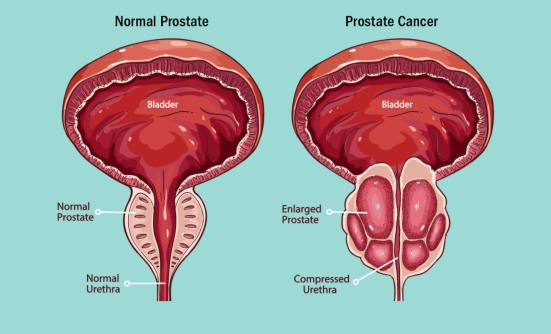Prostate cancer is the most common cancer among men in the United States. As men get older, many are familiar with the increased risk of prostate cancer and the recommendation of annual routine screenings to ensure early detection. What many men do not know is that if a doctor suggests a biopsy to confirm a prostate cancer diagnosis, the current standard biopsy presents several risks that can make the man seriously ill, resulting in hospitalization or a potentially fatal infection.1
As a testicular cancer survivor and a practicing urologist, I knew I needed to find a way to help improve prostate cancer detection, while protecting patients from potential complications of standard biopsies.
Transrectal versus Transperineal Biopsy
The 2 initial tests usually used to detect prostate cancer are a digital rectal exam (DRE) and a prostate-specific antigen (PSA) blood test that are done during an annual physical exam. If either of these tests shows abnormal results, the doctor will likely recommend additional testing to see if the man has prostate cancer. A prostate biopsy is often the next step. There are 2 ways to get the tissue samples from the prostate: (1) through the rectum (transrectal) or (2) through the perineum, the skin between the anus and scrotum (transperineal).
It is well-known among urologists that the second approach (transperineal) is better and safer than the transrectal approach. However, traditionally, doctors have used a device called a grid stepper to perform a transperineal biopsy, which improves the accuracy and eliminates the need to go through the rectum, but it is a long procedure (about an hour) and requires up to 60 needle sticks, which may result in complications for the patient.
Therefore, the transrectal biopsy has become the standard of care for several decades. This approach requires doctors to pass a needle through the man’s rectum to get the sample from the prostate, which can introduce fecal matter and bacteria into the prostate, potentially leading to infection. Furthermore, with a transrectal biopsy, the physician typically needs to perform about 12 needle sticks through the rectum to retrieve prostate tissue samples, putting patients at risk of infection with each needle.1
Generally, patients are given antibiotics either before or after the procedure to prevent infection, but antibiotic resistance is a serious risk. Because of overprescription of antibiotics today, almost one-quarter (25%) of bacteria are resistant to these antibiotics.2
Therefore, patients may still be at risk for infection; about 1% to 6% of patients undergoing prostate biopsy worldwide get a serious infection (called sepsis) that results in hospitalization, and up to a quarter of sepsis cases are fatal.3,4 Other serious potential complications of the transrectal biopsy are injury to blood vessels in the rectal wall, resulting in rectal bleeding. Less serious risks include temporary inability to urinate, pain, and erectile dysfunction.5
An additional drawback of the standard transrectal biopsy is the difficulty to get to certain areas of the prostate where cancer is often found. As a result, up to 30% of prostate cancer is either not identified or misclassified with this type of biopsy.6 Missing cancer often leads to repeated biopsies, until the cancer is ultimately found, exposing patients to the same risks again.
Misclassification of prostate cancer could suggest that the patient has low-risk disease, when in fact he has higher-risk disease that requires immediate treatment rather than just surveillance or monitoring.
Despite the risks and potential complications of the transrectal biopsy, the vast majority of biopsies today are still performed this way: more than 2 million annually in Europe and in North America.7
My own experience as a patient with cancer has taught me the most valuable lessons about being a physician, especially the need to provide the best quality of care to patients, and the appreciation that less is sometimes better. I decided that the risks associated with the transrectal biopsy were unacceptable for patients, and I started the journey to develop a safer approach.
PrecisionPoint: A New and Improved Prostate Biopsy
In the past several years, I have researched and gained a better understanding of the prostate gland, specifically how and where prostate cancer develops (the prostate gland has multiple parts and zones). It has also been beneficial to work with some of the very best experts in urology, and share knowledge.
Through my experience as a urologist, I ultimately developed a new device and surgical method to diagnose prostate cancer, called the “PrecisionPoint Transperineal Access System.”8
This new system allows doctors to perform a prostate biopsy in a revolutionary way that nearly eliminates the complications and risks associated with the standard (transrectal) method.
PrecisionPoint uses a safer, more precise route for getting samples of the prostate, by passing a needle through the perineum (or “the taint”). From there, the prostate is sampled thoroughly, and the patient is experiencing only 2 needle sticks, and little or no discomfort. A transperineal biopsy with PrecisionPoint can be performed under local anesthesia in an office setting in a short time.
The risk of infection using the PrecisionPoint transperineal approach is reduced to nearly zero, and the complications of rectal injury are eliminated.9 Although my major focus in developing this new method was to remove the risk of infection, another equally important benefit is that it allows better access to hard-to-reach areas of the prostate gland during the biopsy, resulting in about 30% better cancer detection rates.8
This new approach also reduces the risks of other complications, including pain, bleeding, and urinary retention. Many men are seeing the direct benefits of PrecisionPoint after years of hearing about the inconveniences, side effects, and potential dangers associated with traditional transrectal biopsies.
Ask Your Doctor
As more men and family members are becoming aware of this new approach to prostate cancer biopsies, it is important that they discuss their options with their physicians. The overall goal for any doctor is to provide the best care possible to patients and to improve their health and quality of life.
PrecisionPoint can provide better and earlier detection of prostate cancer, allowing patients to start treatment sooner and improve their outcomes.
Developing the PrecisionPoint system has been extremely rewarding to me, and together with other urologists, we are working to make it the standard of care in the United States and around the world, to ensure that all men can have the benefits of a better, safer, and more precise biopsy. If your doctor suggests that you should have a prostate biopsy, ask if PrecisionPoint may be a good option for you.
References
- American Urological Association. The prevention and treatment of the more common complications related to prostate biopsy update. Updated 2016. www.auanet.org/guidelines/guidelines/prostate-needle-biopsy-complications.
- Liss MA, Chang A, Santos R, et al. Prevalence and significance of fluoroquinolone resistant Escherichia coli in patients undergoing transrectal ultrasound guided prostate needle biopsy. The Journal of Urology. 2011;185(4):1283-1288.
- Loeb S, Vellekoop A, Ahmed HU, et al. Systematic review of complications of prostate biopsy. European Urology. 2013;64(6):876-892.
- Fleischmann C, Scherag A, Adhikari NKJ, et al. Assessment of global incidence and mortality of hospital-treated sepsis: current estimates and limitations. American Journal of Respiratory and Critical Care Medicine. 2016;193(3):259-272.
- Weiner AB, Manjunath A, Kirsh GM, et al. The cost of prostate biopsies and their complications. Urology Practice. 2020;7(2):145-151.
- Szabo RJ. “Free-hand” transperineal prostate biopsy under local anesthesia. Journal of Endourology. 2021;35(4):525-543.
- Borghesi M, Ahmed H, Nam R, et al. Complications after systematic, random, and image-guided prostate biopsy. European Urology. 2017;71(3):353-365.
- Ristau BT, Allaway M, Cendo D, et al. Free-hand transperineal prostate biopsy provides acceptable cancer detection and minimizes risk of infection: evolving experience with a 10-sector template. Urologic Oncology. 2018;36(12):528.e15-528.e20.
- Lopez JF, Campbell A, Omer A, et al. Local anaesthetic transperineal (LATP) prostate biopsy using a probe-mounted transperineal access system: a multicentre prospective outcome analysis. BJU International. 2021;128(3):311-318.
















